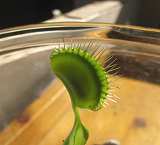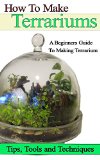If the terrarium you make has soil, real plants, and small animals it is really considered a vivarium which is a bit more challenging to make and maintain but also much more realistic, exciting and rewarding because it is truly like a small biosphere.
About the Animals for your Terrarium

Terrarium Animals from A to Z (Compass Guides) Before you think about your terrarium and the animals that will go into it I want to mention oa couple of important points. If you are making just a terrarium you have a lot of leeway with things like the type of container you use and the types of fertilizer you use. But if you are going to put animals in the terrarium you have to pause and consider that you are now adding a biological entity to your creation and you have to use some common sense. In particular you should avoid chemical fertilizers for the plants. This fertilizer, in a small environment can be toxic to the animals. And this goes the same for cleaners. Avoid using windex or other toxic chemical when cleaning the glass of your terrarium. The natural flow and evaporation of water in the terrarium can cause the chemicals to get concentrated over time and they can accumulate in the water bowls or pools. You also need to consider covering your terrarium. Just a plain terrarium doesn't necessarily need a cover but if there are animals inside I recommend either a full enclosure or a screen on top. You will be surprised by how your animals move around and you don't want them wandering around the house.
Before you think about your terrarium and the animals that will go into it I want to mention oa couple of important points. If you are making just a terrarium you have a lot of leeway with things like the type of container you use and the types of fertilizer you use. But if you are going to put animals in the terrarium you have to pause and consider that you are now adding a biological entity to your creation and you have to use some common sense. In particular you should avoid chemical fertilizers for the plants. This fertilizer, in a small environment can be toxic to the animals. And this goes the same for cleaners. Avoid using windex or other toxic chemical when cleaning the glass of your terrarium. The natural flow and evaporation of water in the terrarium can cause the chemicals to get concentrated over time and they can accumulate in the water bowls or pools. You also need to consider covering your terrarium. Just a plain terrarium doesn't necessarily need a cover but if there are animals inside I recommend either a full enclosure or a screen on top. You will be surprised by how your animals move around and you don't want them wandering around the house.
When you have decided which type of animal you are going to put in a terrarium you should carefully research the animal and how to care for it. They all have specific needs in terms of food, water, drinking, heat, cage construction, sociability and more. I recommend a book on the specific animal or a catch all book about lots of animals like the one I have listed here in this article Terrarium Animals from A to Z (Compass Guides)
What if you are a real beginner to this whole terrarium with animals thing? What type of animal should you get?
I suggest you start out with crickets! Yup, Crickets! They are fun little pets, easy to care for and rather active so they are fun to watch. Of course don't pair them up with other types of animals because they will get eaten. But if you just want a fun way to adventure into a vivarium crickets are great. I have had a few terrariums like this and they really are kind of neat.
There are three important considerations for choosing which animal is right for you:
- Size and growth of the animal: Because it is in an enclosed space you want your animal to be small and to stay small
- Feeding habits of the animal: You don't want an animal that will fight with and eat other animals
- Nondestructiveness: You want an animal that isn't destructive to the terrarium. Animals that dig the soil or eat your plants are not good choices. Turtles fall into this category. They are very destructive in terrariums.
Suggested Animals for your Dry Terrarium, (with just a small water bowl)
- Crickets
- Tarantulas
- American Chameleon (Green Anoles) These are easy to care for and inexpensive
- Toads, but with a caveat; They are great when they are small but when they grow bigger they can be a bit of a hassle.
- Hermit crabs, Can be ok in dry cages but absolutely must have a water dish and things to climb on. You need to spray mist them regularly too. Best for them is a wet bottom terrarium with plenty of options for climbing to stay dry.
- Land Snails - Need a high humidity environment and will dig if your substrate is soil
- Salamanders
- Leopard Gecko
Suggested Animals for Wet Terrariums
The definition of "Wet Terrarium" varies quite a bit from half the terrarium having an inch or two of filtered water to the whole bottom of the terrarium being water. To house one of these kinds of pets you need to carefully research the type of environment it needs and then build your terrarium accordingly.
- Green Tree Frogs
- Red Bellied Toads
- Dwarf African Frogs
- Fire Bellied Frogs
- Tadpoles
- Fire Bellied Newts
- Crayfish
About the right animal for you. I have outlined some of the important points when it comes to choosing the right terrarium animal and you have to consider how much work each of the pets is going to be. The water bound pets are the most care intensive because it involves the cleaning and maintenance of the water. Just remember that you should choose the type of animal, research its habits and needs then design your terrarium (or vivarium) accordingly - with it's needs taking first priority. If you do this you will be rewarded with a healthy and happy pet in an environment that it truly loves. And you will have a great little terrarium that you can admire and show off to others.

Apothecary Jar Terrariums
Here are three wonderful terrariums made by a web visitor (Linda D.) Among other things she used peppermint plants and moss which make a wonderful combination. Check out more pictures and some advice here: The Apothecary terrariums

New: A Venus Fly Trap Terrarium
They are an amazing and exotic plant. And they are great in terrariums. You just have to know some basic rules of care when it comes to these carnivorous plants. I make a terrarium and give you guidelines for a successful Venus Fly Trap Terrarium This also includes a video tutorial.
|
![]()







